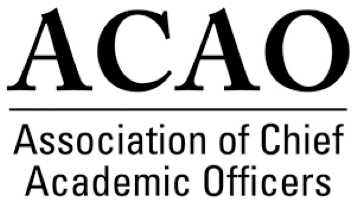Responsibility for digital learning priorities is sometimes situated within universities as if it is only a procurement and resource management function. As a result, important program development, teaching, or instructional design issues can be neglected while decisions about learning technologies are left to the operations branch of the org chart.
When the academic affairs division does have a director of digital learning, that role may be a few steps removed from reporting to the provost, says Laura Niesen de Abruña, the representative for Every Learner Everywhere from The Association of Chief Academic Officers (ACAO), which she helped found and is a past president of. That hands-off approach means university provosts and chief academic officers (CAOs) often aren’t giving enough attention to important strategic decisions.
“It’s too easy to delegate digital learning to an indirect report,” says Niesen de Abruña. “It’s easy for individuals not to know a lot about it and just feel they’re managing it.”
Niesen de Abruña says she often sees institutions with this dynamic in her role at ACAO working with other provosts. “If I was there, I would want to spend a lot of time with the director of digital learning, but it would be getting into somebody else’s business, subverting their authority,” she says. “That sort of structure is very common, particularly in big institutions.”
Niesen de Abruña recently started as Executive Vice President and Provost at Metropolitan State University in Denver, her fifth CAO role over the last twenty years. When Niesen de Abruña was Provost at Sacred Heart University in Connecticut, she had started a Center for Digital Learning. Later, she advocated for programming at ACAO that exposed the organization’s members to more digital learning, eventually developing a grant-funded digital fellows program.
“At the time, we were mostly interested in adaptive learning, and, of course, that broadened,” she says. “Working with Every Learner, I continue to try to provide opportunities for chief academic officers to learn more about digital learning. And it’s been a real ride. We started this well before the pandemic. During the pandemic, we were very active, obviously. And post-pandemic is an interesting situation.”
Niesen de Abruña feels provosts should be actively thinking about and directly influencing four significant unresolved challenges with digital learning.
1. Resuming progress
Niesen de Abruña believes that, while the total amount of digital learning increased dramatically during the Covid-19 lockdowns, it nevertheless stalled important progress.
“The role of digital learning in higher education was really gathering some steam before the pandemic,” she explains. “We need to make sure we’re looking at some of those opportunities again and going back to develop them.”
For example, the emphasis has swung to remote learning, while the potential that digital learning has to support face-to-face courses has been neglected. “When the pandemic hit, everybody turned to video chat and to putting things on their LMS,” she says.
“That passes for digital learning now. Not to denigrate that, but we were working on what tools we can use in face-to-face courses that help students learn better. That’s still there as an issue we need to explore.”
Related reading — Recentering Digital Learning Around Students and Their Needs
2. Critically examine asynchronous
Another effect of Covid-19 was that asynchronous teaching became much more common, and Niesen de Abruña believes provosts need to think about swinging the pendulum back. “I don’t think that is helpful to students at all,” she says.
“If faculty aren’t managed, some of them are just using prefab stuff and not having much interaction with their students,” she points out. “Trying to get a handle on that is important. I’ve been shocked that faculty don’t want to fess up to that reality. Asynchronous presentation, I suppose, has its place, but I don’t know if it has its place at a university for degree-seeking students.”
3. Resolving new management challenges
Niesen de Abruña thinks provosts need to confront the difficult choice between managing an online program in house or partnering with an online program manager (OPM), a choice seemingly influenced by the scale and scope of the institution and its program.
“A lot of smaller institutions really can’t manage digital learning without the aid of a larger organization,” she says. “I’m not sure how confident smaller institutions are in working with OPMs, but I tend to think that can be very helpful.”
Meanwhile, she points out, the U.S. Education Department is casting a critical eye on the contracts universities have with OPMs, particularly when they involve revenue sharing, so the factors influencing this management decision are in flux.
4. Identify the unique differences
Niesen de Abruña says most faculty understand what good pedagogy is and that much of what is presented about teaching with technology is just a rehash of proven concepts.
“We’ve been talking about the principles of evidence-based teaching for a couple of decades,” she says. “If we’re talking about digital learning, we don’t have to go back and tell them what they already know about good teaching. Faculty know that.”
Instead, provosts should be facilitating conversations about what is truly unique to teaching using digital tools.
Taking ownership of digital learning priorities
With the growth of the chief information officer role as a cabinet-level position in higher education, “it became easy for the chief academic officer not to take on digital learning technology as a major priority,” Niesen de Abruña says, but it needs to be. In her work as a provost, she often has a limited set of priorities that she is careful about selecting.
“As a chief academic officer, part of my role is to add value at a higher level than the department or the school level,” she explains. “You have to be careful that your priorities aren’t stepping on the deans’ or the department chairs’ so nobody feels you’re taking ownership of something that’s their bailiwick.”
But digital learning is fundamentally about helping students learn better, she emphasizes, which “should be in the basket of chief academic officers in most institutions.”
Learn more about Every Learner’s services for academic leadership


